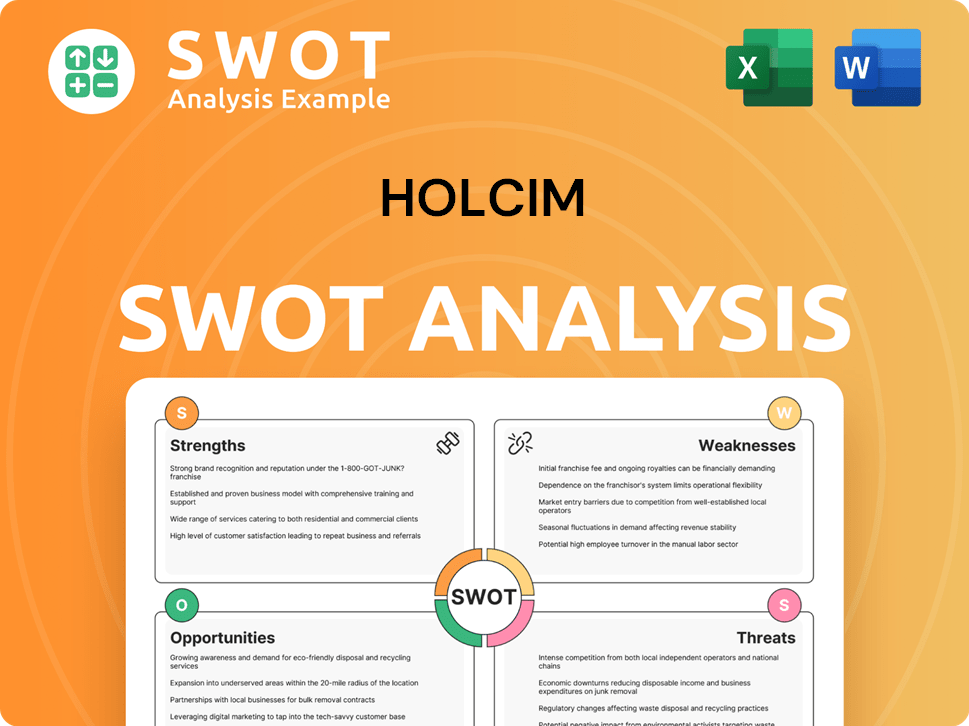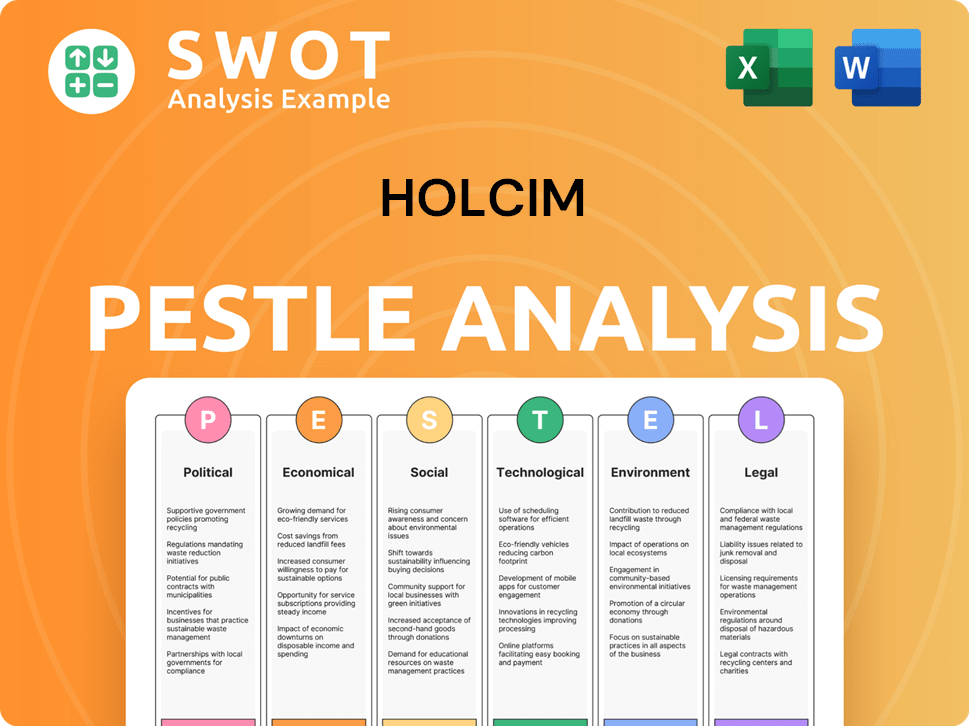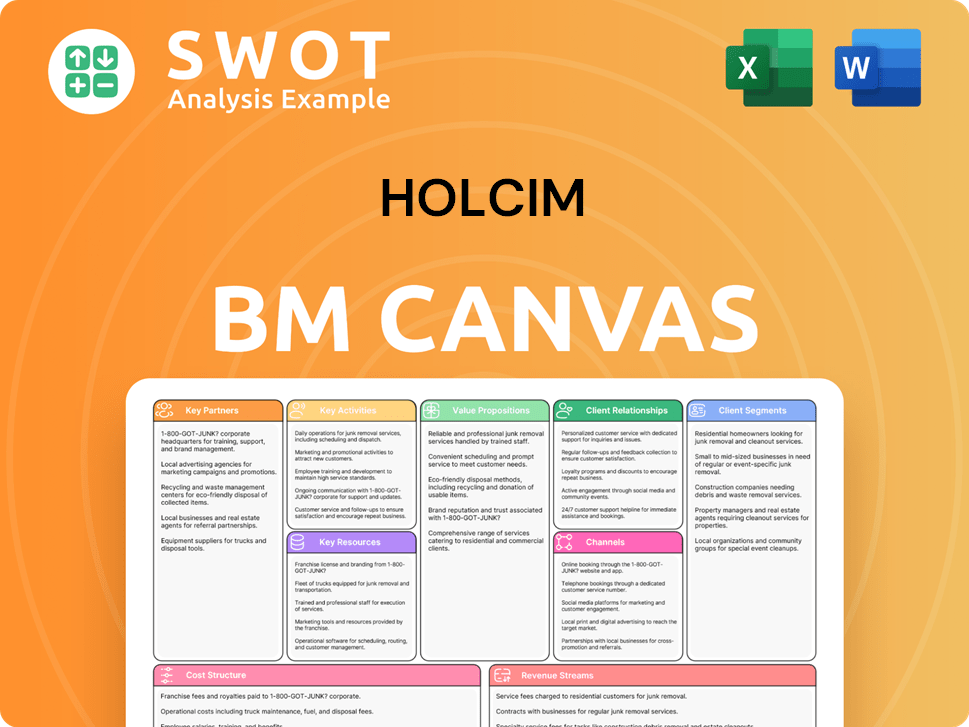Holcim Bundle
Who Really Controls Holcim?
Ever wondered who pulls the strings at one of the world's leading building materials giants? Understanding the Holcim SWOT Analysis is critical for investors and strategists alike. The 2015 merger with Lafarge reshaped the industry, but how has this impacted the

This exploration of
Who Founded Holcim?
The story of Holcim, a global leader in building materials, began in 1912. Adolf Gygi founded the company, initially named 'Aargauische Portlandcementfabrik Holderbank-Wildegg'. This marked the beginning of what would become a significant player in the construction industry.
In 1914, a pivotal moment occurred when the company merged with 'Rheintalischen Cementfabrik Rüthi,' owned by Ernst Schmidheiny. Schmidheiny then took over the leadership role, significantly influencing the company's trajectory. While specific initial equity details for Gygi and Schmidheiny are not readily available, Schmidheiny's leadership and subsequent expansion efforts suggest a substantial stake in the early stages.
The early focus of the Holcim company, then known as Holderbank, was cement manufacturing. It quickly established itself within the local construction sector. By 1922, Holderbank began its international expansion, moving into France. This was followed by further international growth throughout the 1920s through strategic acquisitions. This early strategy of acquiring stakes in existing companies, rather than solely relying on organic growth, demonstrates a focus on consolidating market position and expanding its geographical reach.
Holcim was founded in 1912 by Adolf Gygi as 'Aargauische Portlandcementfabrik Holderbank-Wildegg'.
In 1914, the company merged with 'Rheintalischen Cementfabrik Rüthi,' owned by Ernst Schmidheiny.
Ernst Schmidheiny took over leadership and initiated the company's expansion.
The initial focus was cement manufacturing, quickly becoming a key player in the local construction industry.
By 1922, Holderbank expanded into France and continued to grow internationally through acquisitions.
Early growth involved strategic acquisitions to consolidate market position and expand geographical reach.
The early ownership structure and the founders' vision shaped Holcim's initial growth trajectory. The strategic decisions made during this period, such as the merger with 'Rheintalischen Cementfabrik Rüthi' and the focus on acquisitions, set the stage for the company's future global presence. For more insights into the Holcim group's strategic direction, consider reading about the Growth Strategy of Holcim.
- Adolf Gygi founded the company in 1912.
- Ernst Schmidheiny's leadership from 1914 was crucial.
- Early growth was driven by strategic acquisitions.
- The focus was on cement manufacturing and market consolidation.
Holcim SWOT Analysis
- Complete SWOT Breakdown
- Fully Customizable
- Editable in Excel & Word
- Professional Formatting
- Investor-Ready Format

How Has Holcim’s Ownership Changed Over Time?
The story of Holcim owner began in 1958 when the company went public, marking a significant shift in its ownership structure. This move allowed for broader investment and fueled its expansion, particularly into the Americas during the 1950s and Asia in the 1970s and 1980s. A pivotal moment occurred on July 10, 2015, with the merger with Lafarge, creating LafargeHolcim. This entity was later renamed Holcim Group in 2021, solidifying its position as a global leader in the cement industry. This strategic consolidation reshaped the ownership landscape, integrating two industry giants under a unified structure.
The evolution of Holcim ownership reflects its growth from a privately held entity to a publicly traded global corporation. The merger with Lafarge was a defining event, creating a company with a vast global footprint. The current ownership structure showcases a mix of family legacy and institutional investment, indicative of a mature, publicly traded company. To understand more about its operations, you can read about the Revenue Streams & Business Model of Holcim.
| Shareholder | Stake as of | Percentage |
|---|---|---|
| Thomas Schmidheiny | December 31, 2024 | 6.5% |
| UBS Fund Management (Switzerland) AG | May 9, 2024 | 5.6% |
| BlackRock, Inc. | June 24, 2023 | 5.2% |
| Holcim Ltd | December 31, 2024 | 4.9% |
| The Vanguard Group, Inc. | February 28, 2025 | 4.11674% |
Who owns Holcim today includes a mix of individual and institutional investors. As of December 31, 2024, Thomas Schmidheiny, a descendant of one of the founders, held 6.5% of the shares. Institutional investors such as UBS Fund Management (Switzerland) AG held 5.6% as of May 9, 2024, and BlackRock, Inc. held 5.2% as of June 24, 2023. The company itself held 4.9% of its shares as of December 31, 2024, and The Vanguard Group, Inc. held 4.11674% as of February 28, 2025. This blend of ownership indicates a stable structure with significant institutional backing.
Holcim's ownership structure is a blend of family legacy and institutional investment.
- Thomas Schmidheiny, a descendant of the founders, holds a significant stake.
- Institutional investors like UBS and BlackRock also hold substantial shares.
- The company's evolution reflects its growth from a privately held entity to a global corporation.
- The merger with Lafarge was a key event in shaping its current structure.
Holcim PESTLE Analysis
- Covers All 6 PESTLE Categories
- No Research Needed – Save Hours of Work
- Built by Experts, Trusted by Consultants
- Instant Download, Ready to Use
- 100% Editable, Fully Customizable

Who Sits on Holcim’s Board?
As of May 14, 2025, the Board of Directors for Holcim consists of 10 independent members. The company complies with the Swiss Code of Best Practice for Corporate Governance, which requires that most directors are independent. Kim Fausing was elected as the new Chairman of the Board on May 14, 2025, replacing Jan Jenisch. Other current board members include Philippe Block, Leanne Geale, Catrin Hinkel, Naina Lal Kidwai, Ilias Läber, Michael H. McGarry, Adolfo Orive, Claudia Sender Ramirez, and Sven Schneider. The Nomination, Compensation & Governance Committee includes Ilias Läber, Michael H. McGarry, and Claudia Sender Ramirez, with Leanne Geale newly elected to the committee.
The board's composition reflects a commitment to independent oversight and diverse expertise, ensuring robust governance. This structure is designed to promote transparency and accountability in the company's operations. The board's role is crucial in setting strategic direction and overseeing the company's performance. The board's decisions impact the company's financial health and its ability to compete in the global market. The board's decisions also influence the company's sustainability efforts and its impact on the environment.
| Board Member | Role | Committee Membership |
|---|---|---|
| Kim Fausing | Chairman of the Board | |
| Philippe Block | Board Member | |
| Leanne Geale | Board Member | Nomination, Compensation & Governance Committee |
| Catrin Hinkel | Board Member | |
| Naina Lal Kidwai | Board Member | |
| Ilias Läber | Board Member | Nomination, Compensation & Governance Committee |
| Michael H. McGarry | Board Member | Nomination, Compensation & Governance Committee |
| Adolfo Orive | Board Member | |
| Claudia Sender Ramirez | Board Member | Nomination, Compensation & Governance Committee |
| Sven Schneider | Board Member |
Holcim operates with a one-share-one-vote structure for its registered shares. To have voting rights, shareholders must be registered in the Holcim Ltd share register in Switzerland. Shares not registered are considered 'dispo' shares, which are entitled to dividends but cannot be voted at General Meetings. As of October 31, 2022, the theoretical number of voting rights was 615,929,059, while the number of voting rights exercisable at shareholders' meetings was 375,604,729, indicating a portion of shares without voting rights due to non-registration or being treasury shares. The influence of major shareholders, such as Thomas Schmidheiny, BlackRock, and UBS Fund Management, is significant due to their voting power. For more insights into the company's strategic direction, consider reading about the Growth Strategy of Holcim.
Understanding the structure of Holcim's voting rights is crucial for assessing shareholder influence and the overall governance of the company.
- Registered shares have voting rights.
- Unregistered shares (dispo shares) receive dividends but cannot vote.
- Major shareholders like Thomas Schmidheiny, BlackRock, and UBS Fund Management wield significant influence.
- As of October 31, 2022, the difference between the theoretical and exercisable voting rights highlights the impact of share registration.
Holcim Business Model Canvas
- Complete 9-Block Business Model Canvas
- Effortlessly Communicate Your Business Strategy
- Investor-Ready BMC Format
- 100% Editable and Customizable
- Clear and Structured Layout

What Recent Changes Have Shaped Holcim’s Ownership Landscape?
Over the past few years, the Holcim company has seen significant shifts in its ownership structure and strategic direction. A major development is the planned spin-off of its North American business, Amrize, which is expected to be completed by the end of the first half of 2025. This move, approved by Holcim shareholders on May 14, 2025, with a 99.75% vote in favor, will establish Amrize as a standalone entity focused solely on the North American market. The shares of Amrize Ltd are expected to be listed on the New York Stock Exchange and the SIX Swiss Exchange in June 2025. This strategic move allows Holcim to concentrate on its global operations outside of North America, solidifying its position as a global leader in sustainable construction. Jan Jenisch, who served as Holcim's CEO from 2017 to 2024 and as Chairman since 2023, will lead Amrize as Chairman and CEO.
In addition to the spin-off, Holcim has been active in share buyback programs. The company completed a CHF 1 billion share buyback program initiated on March 18, 2024, repurchasing approximately 12.2 million shares (2.1% of its share capital). The cancellation of these repurchased shares was approved by shareholders on May 14, 2025. This strategy indicates a commitment to returning capital to shareholders. Further illustrating its focus on core markets, Holcim sold its Brazilian cement business in September 2021 for US$1.025 billion and its stake in Ambuja Cements and ACC in India for US$10.5 billion in May 2022. These actions, along with the planned sale of its shareholding in Lafarge Africa Plc to Huaxin Cement, expected to close in 2025, demonstrate a strategic realignment towards key geographical areas.
| Key Development | Details | Impact |
|---|---|---|
| Amrize Spin-off | Separation of North American business, expected by end of H1 2025; Shareholders approved with 99.75% vote. | Focus on North America for Amrize; Holcim concentrates on global sustainable construction. |
| Share Buyback | CHF 1 billion program completed on March 18, 2024, repurchasing approximately 12.2 million shares. | Returns capital to shareholders; potentially increases earnings per share. |
| Strategic Divestments | Sale of Brazilian cement business, stake in Indian entities, and Lafarge Africa Plc. | Focus on core markets and streamlining operations. |
The Holcim group's focus on sustainability is evident, with its ECOPact and ECOPlanet product lines accounting for 36% of total net sales in 2024, reflecting an industry-wide trend towards lower-carbon materials. Furthermore, the company completed 27 acquisitions in 2024, indicating active growth and expansion. For further insights into the company's market position, consider exploring the Target Market of Holcim.
Amrize will focus solely on the North American market.
Holcim will concentrate on global sustainable construction.
Expected listing on NYSE and SIX Swiss Exchange in June 2025.
CHF 1 billion program completed in March 2024.
Approximately 12.2 million shares repurchased.
Shareholders approved cancellation of repurchased shares.
Sale of Brazilian cement business in 2021.
Exit from India in 2022 with sale of stakes.
Planned sale of Lafarge Africa Plc shareholding.
ECOPact and ECOPlanet accounted for 36% of net sales in 2024.
Accelerating shift towards lower-carbon materials.
27 acquisitions completed in 2024.
Holcim Porter's Five Forces Analysis
- Covers All 5 Competitive Forces in Detail
- Structured for Consultants, Students, and Founders
- 100% Editable in Microsoft Word & Excel
- Instant Digital Download – Use Immediately
- Compatible with Mac & PC – Fully Unlocked

Related Blogs
- What are Mission Vision & Core Values of Holcim Company?
- What is Competitive Landscape of Holcim Company?
- What is Growth Strategy and Future Prospects of Holcim Company?
- How Does Holcim Company Work?
- What is Sales and Marketing Strategy of Holcim Company?
- What is Brief History of Holcim Company?
- What is Customer Demographics and Target Market of Holcim Company?
Disclaimer
All information, articles, and product details provided on this website are for general informational and educational purposes only. We do not claim any ownership over, nor do we intend to infringe upon, any trademarks, copyrights, logos, brand names, or other intellectual property mentioned or depicted on this site. Such intellectual property remains the property of its respective owners, and any references here are made solely for identification or informational purposes, without implying any affiliation, endorsement, or partnership.
We make no representations or warranties, express or implied, regarding the accuracy, completeness, or suitability of any content or products presented. Nothing on this website should be construed as legal, tax, investment, financial, medical, or other professional advice. In addition, no part of this site—including articles or product references—constitutes a solicitation, recommendation, endorsement, advertisement, or offer to buy or sell any securities, franchises, or other financial instruments, particularly in jurisdictions where such activity would be unlawful.
All content is of a general nature and may not address the specific circumstances of any individual or entity. It is not a substitute for professional advice or services. Any actions you take based on the information provided here are strictly at your own risk. You accept full responsibility for any decisions or outcomes arising from your use of this website and agree to release us from any liability in connection with your use of, or reliance upon, the content or products found herein.